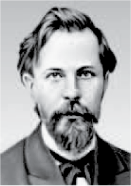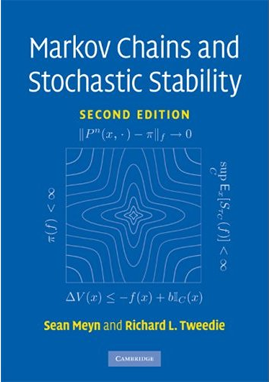* Winner of the 1994 ORSA/TIMS Award for the best research publication in Applied Probability.
This book ... is a most informative and readable text on one of the key themes in probability... Both researchers and users of Markov chain theory will find this scholarly written book indispensible. A definite must on one's bookshelf, and an ideal text for use in a post-graduate course on the subject.
-ISI Short Book Reviews, August 1994.
Download 1993 edition
Second edition published April 2009, and now available on-line for $55.00.
For more information go to Cambridge University, or your favorite retailer.
From the back cover...
This book describes the modern theory of general state space Markov chains, and the application of that theory to operations research, time series analysis, and systems and control theory. It is intended as an advanced graduate text in any of these areas, as well as being a research monograph incorporating a new and thorough treatment of the stability of general Markov chains. There are several key themes in this book which interweave to a surprising extent in both the mathematics and its implementation. There is the use of the splitting technique, which providesan approach to general state space chains through regeneration methods; the systematic use of ``Foster-Lyapunov'' drift criteria, both in improving the theory and in enabling the classification of individual chains; the delineation of appropriate continuity conditions to link the general theory with the properties of chains on, in particular, Euclidean space; and the development of control model approaches, enabling analysis of models from their deterministic counterparts. The applications cover storage systems, including some networks models as well as more traditional GI/G/1 queues and dam models; vector ARMA models including those with random coefficients and bilinear models; and both linear and non-linear state space systems with and without controls. To enhance accessibility, each chapter begins with a development of countable state space chains if appropriate. The general state space theory is then developed in close analogy, and where possible the theory is then specialized to chains on a topological state space, such as Euclidean space, so that the special structure of such spaces can be explored. The book is divided into three parts. Chains which are psi-irreducible are the focus of this book, and it is in Part I that this class of chains is initially developed. Numerous applications are described, and the foundations and basic definitions are developed directly, and illustrated through these applications. In the second part a description of the possible stable regimes for a Markov chain are described. The dichotomies which exist between transience and recurrence are developed here, and positive recurrence is described for general state space chains. Drift criteria are introduced to enable practical verification of the various forms of stability for specific models. In Part III existing and new ergodic theory is presented, and here the drift criterion approach makes its full impact. Total variation norm limit theorems, laws of large numbers, and functional central limit theorems are obtained through the combined use of drift criteria and splitting techniques. Many of the theoretical results appear here for the first time, and much of the theory and the models which are used to illustrate the theory, and to provide extensions of the theory in special cases, have not previously been brought together in book form. This book thus provides a readable account of the development over the last two decades of a fundamental and applicable area of stochastic processes, and as such will be of value not only in probability theory but in the many discplines where these models form the basis of analysis.
New Monograph:
 |
Control Techniques for Complex Networks Based on Meyn & Tweedie, with applications to simulation, optimization, ODE methods, as well as network control and performance evaluation |


